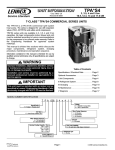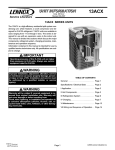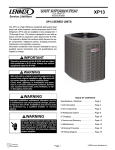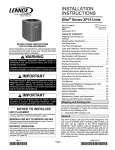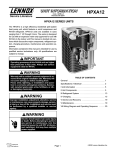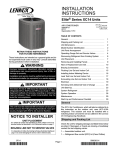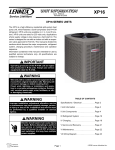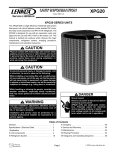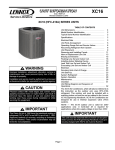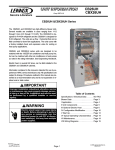Download 13HPX Series - HvacPartsShop.com
Transcript
13HPX Corp. 0619−L4 Revised 04−2009 Service Literature 1.5 to 5 ton 13HPX SERIES UNITS The 13HPX is a residential split-system heat pump. The series is designed for use with expansion valves (TXV) and R−410A refrigerant. All 13HPX units utilize scroll compressors. 13HPX series units are available in 1 1/2, 2, 2 -1/2, 3, 3 -1/2, 4 and 5 ton capacities. All major components (indoor blower and coil) must be matched according to Lennox recommendations for the compressor to be covered under warranty. Refer to the Engineering Handbook for approved system matchups. This manual is divided into sections which discuss the major components, refrigerant system, charging procedure, maintenance and operation sequence. Information contained in this manual is intended for use by qualified service technicians only. All specifications are subject to change. ELECTROSTATIC DISCHARGE (ESD) Precautions and Procedures CAUTION CAUTION Electrostatic discharge can affect electronic components. Take precautions during unit installation and service to protect the unit’s electronic controls. Precautions will help to avoid control exposure to electrostatic discharge by putting the unit, the control and the technician at the same electrostatic potential. Neutralize electrostatic charge by touching hand and all tools on an unpainted unit surface before performing any service procedure. In order to avoid injury, take proper precaution when lifting heavy objects. Table of Contents Specifications / Electrical Data . . . . . . . . . . . . . . . . . . . 2 I Unit Components . . . . . . . . . . . . . . . . . . . . . . . . . . . . . 4 II Refrigerant System . . . . . . . . . . . . . . . . . . . . . . . . . . . 9 WARNING III Charging . . . . . . . . . . . . . . . . . . . . . . . . . . . . . . . . . . . 11 Refrigerant can be harmful if it is inhaled. Refrigerant must be used and recovered responsibly. IV Maintenance . . . . . . . . . . . . . . . . . . . . . . . . . . . . . . . . 14 Failure to follow this warning may result in personal injury or death. V Brazing Procedure . . . . . . . . . . . . . . . . . . . . . . . . . . . 14 VI Diagrams . . . . . . . . . . . . . . . . . . . . . . . . . . . . . . . . . . 15 MODEL NUMBER IDENTIFICATION 13 HP X − 024 − 230 − 2 Minor Revision Number Voltage 230 = 208/230V−1phase−60hz Nominal Cooling Capacity 018 = 1.5 tons 024 = 2 tons 030 = 2.5 tons 036 = 3 tons 042 = 3.5 tons 048 = 4 tons 060 = 5 tons 061 = 5+ tons Nominal SEER Unit Type HP = Heat Pump Outdoor Unit Refrigerant X = R−410A Page 1 © 2006 Lennox Industries Inc. SPECIFICATIONS General Data Model No. Nominal Tonnage 1 Sound Rating Number Connections (sweat) Liquid line o.d. − in. Vapor line o.d. − in. 2 Refrigerant R−410A charge furnished Outdoor Net face area Outer coil Coil sq. ft. Inner coil Tube diameter − in. No. of rows Fins per inch Diameter − in. Outdoor Fan No. of Blades Motor hp Cfm Rpm Watts Shipping Data − lbs. 1 package 13HPX−018 1.5 76 3/8 3/4 7 lbs. 4 oz. 15.21 −−− 5/16 1 22 18 3 1/5 2400 1130 166 140 13HPX−024 2 76 3/8 3/4 7 lbs. 8 oz. 15.21 −−− 5/16 1 22 18 3 1/5 2400 1130 166 150 13HPX−030 2.5 76 3/8 3/4 8 lbs. 6 oz. 13.30 12.60 5/16 2 22 18 4 1/5 2440 1095 194 170 13HPX−036 3 76 3/8 7/8 8 lbs. 12 oz. 15.21 14.50 5/16 2 22 18 4 1/5 2450 1100 190 180 208/230V 20 12.3 9.0 48 0.96 1.1 1.9 208/230V 30 17.9 13.5 58.3 0.97 1.1 1.9 208/230V 30 18.7 14.1 73 0.98 1.1 1.9 208/230V 35 21.9 16.7 79 0.98 1.1 1.9 S S S S S S S S S S S S S S S S S S S S S S S S S S S S S S S S S S S S S S S S S S S ELECTRICAL DATA Line voltage data − 60 hz − 1ph overcurrent protection (amps) 4 Minimum circuit ampacity Rated Load Amps Locked Rotor Amps Power Factor Full Load Amps Locked Rotor Amps 3 Maximum Compressor Outdoor Fan Motor OPTIONAL ACCESSORIES − must be ordered extra Compressor Crankcase Heater Compressor Hard Start Kit 93M05 10J42 88M91 Compressor Low Ambient Cut−Off 45F08 Compressor Sound Cover 69J03 3/8 in. tubing 93G35 Freezestat 5/8 in. tubing 50A93 92M89 Hail Guards 92M88 5 Low Ambient Kit 54M89 Low Pressure Switch Bypass Thermostat 13W07 Mild Weather Kit 33M07 Monitor Kit − Service Light 76F53 Mounting Base 69J06 Thermostat 56A87 Outdoor Thermostat Kit Mounting Box 31461 L15−41−20 L15−41−40 Refrigerant L15−41−30 L15−41−50 Line Sets L15−65−30 L15−65−40 L15−65−50 Time Delay Relay Kit 58M81 Unit Stand−Off Kit 94J45 S S S S S S S S S S S S S S S S S S S S S NOTE − Extremes of operating range are plus 10% and minus 5% of line voltage. 1 Sound Rating Number rated in accordance with test conditions included in ARI Standard 270. 2 Refrigerant charge sufficient for 15 ft. length of refrigerant lines. 3 HACR type circuit breaker or fuse. 4 Refer to National or Canadian Electrical Code manual to determine wire, fuse and disconnect size requirements. 5 Crankcase Heater and Freezestat are recommended with Low Ambient Kit. Page 2 S S S S SPECIFICATIONS General Data Model No. Nominal Tonnage 1 Sound Rating Number Connections (sweat) Liquid line o.d. − in. Vapor line o.d. − in. 2 Refrigerant R−410A charge furnished Outdoor Net face area Outer coil Coil sq. ft. Inner coil Tube diameter − in. No. of rows Fins per inch Diameter − in. Outdoor Fan No. of Blades Motor hp Cfm Rpm Watts Shipping Data − lbs. 1 package 13HPX−042 3.5 80 3/8 7/8 10 lbs. 10 oz. 18.66 17.95 5/16 2 22 22 4 1/3 3890 1080 400 220 13HPX−048 4 80 3/8 7/8 13 lbs. 2 oz. 21.11 20.31 5/16 2 22 22 4 1/3 3890 1085 375 250 13HPX−060 5 80 3/8 1-1/8 15 lbs. 3 oz. 24.50 23.56 5/16 2 22 22 4 1/4 3830 825 330 255 13HPX−061 5 80 3/8 1-1/8 15 lbs. 9 oz. 29.09 28.16 5/16 2 22 26 4 1/3 45500 830 307 298 208/230V 40 24.1 17.9 112 0.94 1.7 4.1 208/230V 50 28.9 21.8 117 0.95 1.7 4.1 208/230V 60 34.6 26.3 134 0.98 1.7 3.1 208/230V 60 34.6 26.3 134 0.98 1.8 2.9 S S S S S S S S S S S S S S S S S S S S S S S S S ELECTRICAL DATA Line voltage data − 60 hz − 1ph overcurrent protection (amps) 4 Minimum circuit ampacity Rated Load Amps Locked Rotor Amps Power Factor Full Load Amps Locked Rotor Amps 3 Maximum Compressor Outdoor Fan Motor OPTIONAL ACCESSORIES − must be ordered extra Compressor Crankcase Heater Compressor Hard Start Kit Compressor Low Ambient Cut−Off Compressor Sound Cover 3/8 in. tubing Freezestat 5/8 in. tubing Hail Guards Factory 88M91 45F08 69J03 93G35 50A93 12W21 92M90 92M94 94M94 5 Low Ambient Kit 54M89 Low Pressure Switch Bypass Thermostat 13W07 Mild Weather Kit 33M07 Monitor Kit − Service Light 76F53 Mounting Base 69J07 Thermostat 56A87 Outdoor Thermostat Kit Mounting Box 31461 L15−65−30 L15−65−40 Refrigerant L15−65−50 Line Sets Field Fabricate Time Delay Relay Kit 58M81 Unit Stand−Off Kit 94J45 S S S S S S S S S S S S S S S S S S S S S S NOTE − Extremes of operating range are plus 10% and minus 5% of line voltage. 1 Sound Rating Number rated in accordance with test conditions included in ARI Standard 270. 2 Refrigerant charge sufficient for 15 ft. length of refrigerant lines. 3 HACR type circuit breaker or fuse. 4 Refer to National or Canadian Electrical Code manual to determine wire, fuse and disconnect size requirements. 5 Crankcase Heater and Freezestat are recommended with Low Ambient Kit. Page 3 S S S S S S S S S S S S S S S S S S S S S I − UNIT COMPONENTS A − Control Box (Figure 2) Unit components are illustrated in figure 1. 13HPX units are not equipped with a 24V transformer. All 24 VAC controls are powered by the indoor unit. Refer to wiring diagram. 13HPX UNIT COMPONENTS low pressure switch (located on suction line) condenser fan Electrical openings are provided under the control box cover. Field thermostat wiring is made to a 24V terminal strip located on the defrost control board located in the control box. See figure 3. txv valve 24V THERMOSTAT TERMINAL STRIP W1 muffler C L R O FIGURE 3 Y1 1 − Compressor Contactor K1 compressor service valves drier reversing valve The compressor is energized by a contactor located in the control box. See figure 2. Single−pole contactors are used in 13HPX series units. See wiring diagrams for specific unit. K1 is energized through the CMC1 board by the indoor thermostat terminal Y1 (24V) when thermostat demand is present. high pressure switch (on liquid line, hidden) DANGER FIGURE 1 Electric Shock Hazard. May cause injury or death. 13HPX UNIT CONTROL BOX Disconnect all remote electrical power supplies before opening unit panel. Unit may have multiple power supplies. DUAL CAPACITOR (C12) Some units are equipped with single− pole contactors. When unit is equipped with a single−pole contactor, line voltage is present at all components (even when unit is not in operation). COMPRESSOR CONTACTOR (K1) GROUNDING LUG DEFROST CONTROL (CMC1) FIGURE 2 2 − Dual Capacitor C12 The compressor and fan in 13HPX series units use permanent split capacitor motors. The capacitor is located inside the unit control box (see figure 2). A single dual" capacitor (C12) is used for both the fan motor and the compressor (see unit wiring diagram). The fan side and the compressor side of the capacitor have different MFD ratings. Page 4 3 − Defrost System The 13HPX defrost system includes two components: a defrost thermostat and a defrost control. Defrost Thermostat The defrost thermostat is located on the liquid line between the check/expansion valve and the distributor. When defrost thermostat senses 42°F (5.5°C) or cooler, the thermostat contacts close and send a signal to the defrost control board to start the defrost timing. It also terminates defrost when the liquid line warms up to 70°F (21°C). Defrost Control The defrost control board includes the combined functions of a time/temperature defrost control, defrost relay, diagnostic LEDs and terminal strip for field wiring connections. See figure 4. The control provides automatic switching from normal heating operation to defrost mode and back. During compressor cycle (call for defrost), the control accumulates compressor run times at 30-, 60-, or 90-minute field−adjustable intervals. If the defrost thermostat is closed when the selected compressor run time interval ends, the defrost relay is energized and defrost begins. 13HPX Outdoor Unit Defrost Control Board interval on the 5 ton unit but a 90−minute defrost interval on all other 13HPX size units. If the timing selector jumper is not in place, the control defaults to a 90−minute defrost interval. The maximum defrost period is 14 minutes and cannot be adjusted. A TEST option is provided for troubleshooting. The TEST mode may be started any time the unit is in the heating mode and the defrost thermostat is closed or jumpered. If the jumper is in the TEST position at power-up, the control will ignore the test pins. When the jumper is placed across the TEST pins for two seconds, the control will enter the defrost mode. If the jumper is removed before an additional 5−second period has elapsed (7 seconds total), the unit will remain in defrost mode until the defrost thermostat opens or 14 minutes have passed. If the jumper is not removed until after the additional 5−second period has elapsed, the defrost will terminate and the test option will not function again until the jumper is removed and re−applied. Compressor Delay The defrost board has a field−selectable function to reduce occasional sounds that may occur while the unit is cycling in and out of the defrost mode. The compressor will be cycled off for 30 seconds going in and out of the defrost mode when the compressor delay jumper is removed. NOTE − The 30-second off" cycle is not functional when jumpering the TEST pins. Time Delay The timed-off delay is five minutes long. The delay helps to protect the compressor from short-cycling in case the power to the unit is interrupted or a pressure switch opens. The delay is bypassed by placing the timer select jumper across the TEST pins for 0.5 seconds. Timing Pins LED’s Test Pins Compressor Delay Pins Pressure Switch Circuit Reversing Valve 24v terminal strip Low Pressure Switch (S87) Defrost Thermostat High Pressure Switch (S4) FIGURE 4 Defrost Control Timing Pins Each timing pin selection provides a different accumulated compressor run time period for one defrost cycle. This time period must occur before a defrost cycle is initiated. The defrost interval can be adjusted to 30 (T1), 60 (T2), or 90 (T3) minutes (see figure 4). The defrost timing jumper is factory−installed to provide a 60−minute defrost Page 5 The defrost control incorporates two pressure switch circuits. The high pressure switch (S4) connects to the board’s HI PS terminals. The board also includes terminals LO−PS for a low pressure switch (S87). See figure 4 for switch terminal location. During a single demand cycle, the defrost control will lock out the unit after the fifth time that the circuit is interrupted by any pressure switch wired to the control board. In addition, the diagnostic LEDs will indicate a locked-out pressure switch after the fifth occurrence of an open pressure switch (see Table 1). The unit will remain locked out until power to the board is interrupted, then re-established or until the jumper is applied to the TEST pins for 0.5 seconds. NOTE − The defrost control board ignores input from the low-pressure switch terminals as follows: S during the TEST mode, S during the defrost cycle, S during the 90-second start-up period, S and for the first 90 seconds each time the reversing valve switches heat/cool modes. If the TEST pins are jumpered and the 5-minute delay is being bypassed, the LO PS terminal signal is not ignored during the 90-second start-up period. Diagnostic LEDs SCROLL FORM The defrost board uses two LEDs for diagnostics. The LEDs flash a specific sequence according to the condition. TABLE 1 Defrost Control Board Diagnostic LED Mode Green LED (DS2) Red LED (DS1) No power to control OFF OFF Normal operation / power to control Simultaneous Slow FLASH Anti-short cycle lockout (5 minute) Alternating Slow FLASH Low pressure switch fault OFF Slow FLASH Low pressure switch lockout OFF ON High pressure switch fault Slow FLASH OFF High pressure switch lockout ON OFF FIGURE 6 CROSS−SECTION OF SCROLLS DISCHARGE STATIONARY SCROLL DISCHARGE PRESSURE SUCTION TIPS SEALED BY DISCHARGE PRESSURE B − Compressor All 13HPX units utilize a scroll compressor. The scroll compressor design is simple, efficient and requires few moving parts. A cutaway diagram of the scroll compressor is shown in figure 5. The scrolls are located in the top of the compressor can and the motor is located just below. The oil level is immediately below the motor. The scroll is a simple compression concept centered around the unique spiral shape of the scroll and its inherent properties. Figure 6 shows the basic scroll form. Two identical scrolls are mated together forming concentric spiral shapes (figure 7). One scroll remains stationary, while the other is allowed to "orbit" (figure 8). Note that the orbiting scroll does not rotate or turn but merely orbits the stationary scroll. SCROLL COMPRESSOR DISCHARGE SUCTION FIGURE 5 NOTE − During operation, the head of a scroll compressor may be hot since it is in constant contact with discharge gas. ORBITING SCROLL FIGURE 7 The counterclockwise orbiting scroll draws gas into the outer crescent shaped gas pocket created by the two scrolls (figure 8 − 1). The centrifugal action of the orbiting scroll seals off the flanks of the scrolls (figure 8 − 2). As the orbiting motion continues, the gas is forced toward the center of the scroll and the gas pocket becomes compressed (figure 8 − 3). When the compressed gas reaches the center, it is discharged vertically into a chamber and discharge port in the top of the compressor (figure 7). The discharge pressure forcing down on the top scroll helps seal off the upper and lower edges (tips) of the scrolls (figure 7). During a single orbit, several pockets of gas are compressed simultaneously providing smooth continuous compression. The scroll compressor is tolerant to the effects of liquid return. If liquid enters the scrolls, the orbiting scroll is allowed to separate from the stationary scroll. The liquid is worked toward the center of the scroll and is discharged. If the compressor is replaced, conventional Lennox cleanup practices must be used. Due to its efficiency, the scroll compressor is capable of drawing a much deeper vacuum than reciprocating compressors. Deep vacuum operation can cause internal fusite arcing resulting in damaged internal parts and will result in compressor failure. Never use a scroll compressor for evacuating or pumping−down" the system. This type of damage can be detected and will result in denial of warranty claims. The scroll compressor is quieter than a reciprocating compressor, however, the two compressors have much different sound characteristics. The sounds made by a scroll compressor do not affect system reliability, performance, or indicate damage. See compressor nameplate and ELECTRICAL DATA table on page 2 for compressor specifications. Page 6 SUCTION SUCTION 1 INTERMEDIATE PRESSURE GAS 2 ORBITING SCROLL CRESCENT SHAPED GAS POCKET STATIONARY SCROLL SUCTION POCKET FLANKS SEALED BY CENTRIFUGAL FORCE SUCTION SUCTION MOVEMENT OF ORBIT 3 CONDENSER FAN MOTOR AND COMPRESSOR ACCESS FAN GUARD Remove (7) screws 4 HIGH PRESSURE GAS FAN POCKET FIGURE 8 Access to the condenser fan motor on all units is gained by removing the seven screws securing the fan assembly. See figure 9. The outdoor fan motor is removed from the fan guard by removing the four nuts found on the top panel. If replacing outdoor fan motor on the 13HPX−060, align motor shaft 1/4" from the hub. For all other 13HPX model units, motor shaft should be flush with hub. See figure 9. Drip loops should be used in wiring when servicing motor. WIRING Remove (4) nuts REMOVE (7) SCREWS SECURING FAN GUARD. REMOVE FAN GUARD/ FAN ASSEMBLY. DISCHARGE ALIGN FAN HUB FLUSH WITH MOTOR SHAFT. ON −060 UNITS SHAFT SHOULD BE 1/4" FROM HUB. D − Reversing Valve L1 and Solenoid A refrigerant reversing valve with electromechanical solenoid is used to reverse refrigerant flow during unit operation. The reversing valve requires no maintenance. The only replaceable part is the solenoid. If the reversing valve itself has failed, it must be replaced. If replacement is necessary, access reversing valve by removing the outdoor fan motor. Refer to figure 9. E − High Pressure Switch S4 IMPORTANT FIGURE 9 Pressure switch settings for R−410A refrigerant will be significantly higher than units with R−410A. DANGER An auto-reset, single-pole/single-throw high pressure switch is located in the liquid line. This switch shuts off the compressor when liquid line pressure rises above the factory setting. The switch is normally closed and is permanently adjusted to trip (open) at 590 + 15 psi. Make sure all power is disconnected before beginning electrical service procedures. C − Outdoor Fan Motor All units use single−phase PSC fan motors which require a run capacitor. In all units, the condenser fan is controlled by the compressor contactor (and defrost control during defrost cycles). ELECTRICAL DATA tables in this manual show specifications for condenser fans used in 13HPXs. Page 7 F − Low Pressure Switch S87 An auto-reset, single-pole/single-throw low pressure switch is located in the suction line. This switch shuts off the compressor when suction pressure drops below the factory setting. The switch is closed during normal operating pressure conditions and is permanently adjusted to trip (open) at 25 + 5 psi. The switch automatically resets when suction line pressure rises above 40 + 5 psi. Under certain conditions the low pressure switch is ignored. See Pressure Switch Circuit in the Defrost Control description. than 4 psig. To safeguard against moisture entering the system follow the steps in section III − sub section C − "Evacuating the System" when replacing the drier. H − Crankcase Heater HR1 & Thermostat S40 (options) G − Drier Crankcase heater HR1 is an option for all size units, while thermostat S40 is an option for 5 ton units only. HR1 is a 40 watt heater that prevents liquid from accumulating in the compressor. In the 13HPX−060 (5 ton unit) HR1 is controlled by thermostat S40 located in the liquid line. When liquid line temperature drops below 50° F, S40 closes energizing HR1. S40 will open once liquid line temperature reaches 70°, de−energizing HR1. A filter drier designed for all 13HPX model units is factory installed in the liquid line. The filter drier is designed to remove moisture and foreign matter, which can lead to compressor failure. Moisture and / or Acid Check Because POE oils absorb moisture, the dryness of the system must be verified any time the refrigerant system is exposed to open air. A compressor oil sample must be taken to determine if excessive moisture has been introduced to the oil. Table 2 lists kits available from Lennox to check POE oils. TABLE 2 KIT If oil sample taken from a system that has been exposed to open air does not test in the dry color range, the filter drier MUST be replace. IMPORTANT TUBE SHELF LIFE CONTENTS 10N46 − Refrigerant Analysis Checkmate−RT700 10N45 − Acid Test Tubes Checkmate−RT750A (three pack) 2 − 3 years @ room temperature. 3+ years refrigerated 10N44 − Moisture Test Tubes Checkmate − RT751 Tubes (three pack) 6 − 12 months @ room temperature. 2 years refrigerated 74N40 − Easy Oil Test Tubes Checkmate − RT752C Tubes (three pack) 2 − 3 years @ room temperature. 3+ years refrigerated 74N39 − Acid Test Kit Sporian One Shot − TA−1 Replacement filter drier MUST be approved for R−410A refrigerant and POE application. Foreign Matter Check It is recommended that a liquid line filter drier be replaced when the pressure drop across the filter drier is greater II − REFRIGERANT SYSTEM 13HPX COOLING CYCLE (SHOWING MANIFOLD GAUGE CONNECTIONS) OUTDOOR UNIT DEFROST THERMOSTAT DISTRIBUTOR REVERSING VALVE EXPANSION/CHECK VALVE BIFLOW FILTER / DRIER OUTDOOR COIL LOW PRESSURE INDOOR UNIT HIGH PRESSURE MUFFLER GAUGE MANIFOLD TO R−410A DRUM LIQUID LINE SERVICE PORT SUCTION SERVICE PORT VAPOR LINE VALVE COMPRESSOR EXPANSION/CHECK VALVE NOTE − ARROWS INDICATE DIRECTION OF REFRIGERANT FLOW FIGURE 10 Page 8 INDOOR COIL 13HPX HEATING CYCLE (SHOWING MANIFOLD GAUGE CONNECTIONS) OUTDOOR UNIT DEFROST THERMOSTAT DISTRIBUTOR REVERSING VALVE EXPANSION/CHECK VALVE BIFLOW FILTER / DRIER OUTDOOR COIL LOW PRESSURE INDOOR UNIT HIGH PRESSURE MUFFLER GAUGE MANIFOLD TO R−410A DRUM SUCTION SERVICE PORT LIQUID LINE SERVICE PORT VAPOR LINE VALVE COMPRESSOR EXPANSION/CHECK VALVE INDOOR COIL NOTE − ARROWS INDICATE DIRECTION OF REFRIGERANT FLOW FIGURE 11 Each valve is equipped with a service port. The service ports A − Plumbing are used for leak testing, evacuating, charging and checking Field refrigerant piping consists of liquid and vapor lines charge. A Schrader valve is factory installed. A service port from the outdoor unit (sweat connections). Use Lennox cap is supplied to protect the Schrader valve from contaminaL15 (sweat) series line sets as shown in table 3. tion and serve as the primary leak seal. TABLE 3 NOTE-Always keep valve stem caps clean. Refrigerant Line Sets To Access Schrader Port: Model Field Connections Recommended Line Set −018 −024 −030 3/8 in. (10 mm) 3/4 in (19 mm) 3/8 in. (10 mm) 3/4 in (19 mm) L15−41 15 ft. − 50 ft. (4.6 m − 15 m) −036 −042 −048 3/8 in. (10 mm) 7/8 in (22 mm) 3/8 in. (10 mm) 7/8 in (22 mm) L15−65 15 ft. − 50 ft. (4.6 m − 15 m) To Open Liquid or Vapor Line Service Valve: −060 −061 3/8 in. (10 mm) 1−1/8 in. (29 mm) 3/8 in. (10 mm) 1−1/8 in. (29 mm) Field Fabricated 2 − Using service wrench and hex head extension (5/16 for vapor line and 3/16 for liquid line), back the stem out counterclockwise until the valve stem just touches the retaining ring. B − Service Valves 1 − Remove service port cap with an adjustable wrench. 2 − Connect gauge to the service port. 3 − When testing is completed, replace service port cap. Tighten finger tight, then an additional 1/6 turn. 1 − Remove stem cap with an adjustable wrench. 3 − Replace stem cap and tighten finger tight, then tighten an additional 1/6 turn. IMPORTANT DANGER Only use Allen wrenches of sufficient hardness (50Rc − Rockwell Harness Scale min). Fully insert the wrench into the valve stem recess. Service valve stems are factory torqued (from 9 ft lbs for small valves, to 25 ft lbs for large valves) to prevent refrigerant loss during shipping and handling. Using an Allen wrench rated at less than 50Rc risks rounding or breaking off the wrench, or stripping the valve stem recess. Do not attempt to backseat this valve. Attempts to backseat this valve will cause snap ring to explode from valve body under pressure of refrigerant. Personal injury and unit damage will result. To Close Liquid or Vapor Line Service Valve: The liquid and vapor line service valves (figures 12 and 13) and gauge ports are accessible from outside the unit. Page 9 1 − Remove stem cap with an adjustable wrench. 2 − Using service wrench and hex head extension (5/16 for vapor line and 3/16 for liquid line), turn stem clockwise to seat the valve. Tighten firmly. 3 − Replace stem cap. Tighten finger tight, then tighten an additional 1/6 turn. SUCTION LINE (BALL TYPE) SERVICE VALVE (VALVE OPEN) USE ADJUSTABLE WRENCH ROTATE STEM CLOCKWISE 90_ TO CLOSE ROTATE STEM COUNTER-CLOCKWISE 90_ TO OPEN LIQUID LINE SERVICE VALVE (VALVE OPEN) STEM CAP TO COMPRESSOR INSERT HEX WRENCH HERE STEM CAP STEM SERVICE PORT BALL (SHOWN OPEN) TO COMPRESSOR FROM INDOOR COIL SERVICE PORT CAP SERVICE PORT CAP TO INDOOR COIL SCHRADER VALVE SERVICE PORT SCHRADER CORE LIQUID LINE SERVICE VALVE (VALVE CLOSED) FIGURE 13 III − CHARGING A − Pumping Down System RETAINING RING STEM CAP SERVICE PORT CAUTION Deep vacuum operation (operating compressor at 0 psig or lower) can cause internal fusite arcing resulting in a damaged or failed compressor. This type of damage will result in denial of warranty claim. INSERT HEX WRENCH HERE TO COMPRESSOR SERVICE PORT CAP SCHRADER VALVE OPEN TO LINE SET WHEN VALVE IS CLOSED (FRONT SEATED) The system may be pumped down when leak checking the line set and indoor coil or making repairs to the line set or indoor coil. 1− Attach gauge manifold. TO INDOOR COIL VALVE FRONT SEATED 2− Front seat (close) liquid line valve. 3− Start outdoor unit. FIGURE 12 4− Monitor suction gauge. Stop unit when 0 psig is reached. 5− Front seat (close) suction line valve. Vapor Line (Ball Type) Service Valve A ball-type full service valve is used on 13HPX. Valves are not re−buildable. If a valve has failed it must be replaced. A ball valve is illustrated in figure 13. The ball valve is equipped with a service port. A Schrader valve is factory installed. A service port cap is supplied to protect the Schrader valve from contamination and assure a leak free seal. B − Leak Testing (To Be Done Before Evacuating) 1− Attach gauge manifold and connect a drum of dry nitrogen to center port of gauge manifold. 2− Open high pressure valve on gauge manifold and pressurize line set and indoor coil to 150 psig (1034 kPa). 3− Check lines and connections for leaks. Page 10 stop vacuum pump and disconnect from gauge manifold. Attach an upright nitrogen drum to center port of gauge manifold and open drum valve slightly to purge line at manifold. Break vacuum in system with nitrogen pressure by opening manifold high pressure valve. Close manifold high pressure valve to center port. 4− Close nitrogen drum valve and disconnect from gauge manifold center port. Release nitrogen pressure from system. 5− Connect vacuum pump to gauge manifold center port. Evacuate system through manifold service valves until vacuum in system does not rise above .5mm of mercury absolute pressure or 500 microns within a 20−minute period after stopping vacuum pump. 6− After evacuation is complete, close manifold center port, and connect refrigerant drum. Pressurize system slightly with refrigerant to break vacuum. NOTE-The preferred method is to use an electronic leak or Halide detector. Add a small amount of R−410A (3 to 5 psig [20kPa to 34kPa]) then pressurize with nitrogen to 150 psig. 4− Release nitrogen pressure from the system, correct any leaks and recheck. WARNING Fire, Explosion and Personal Safety Hazard. Failure to follow this warning could result in damage, personal injury or death. Never use oxygen to pressurize or purge refrigeration lines. Oxygen, when exposed to a spark or open flame, can cause damage by fire and / or an explosion, that can result in personal injury or death. D − Charging WARNING Danger of explosion! When using a high pressure gas such as dry nitrogen to pressurize a refrigerant or air conditioning system, use a regulator that can control the pressure down to 1 or 2 psig (6.9 to 13.8 kPa). C − Evacuating the System 1− Attach gauge manifold. Connect vacuum pump (with vacuum gauge) to center port of gauge manifold. With both manifold service valves open, start pump and evacuate indoor coil and refrigerant lines. This system is charged with HFC−410A refrigerant which operates at much higher pressures than HCFC−22. The recommended check expansion valve is approved for use with HFC−410A. Do not replace it with a valve that is designed to be used with HCFC−22. This unit is NOT approved for use with coils that include metering orifices or capillary tubes. The unit is factory−charged with the amount of HFC−410A refrigerant indicated on the unit rating plate. This charge is based on a matching indoor coil and outdoor coil with a 15 foot (4.6 m) line set. A blank space is provided on the unit rating plate to list the actual field charge. IMPORTANT IMPORTANT A temperature vacuum gauge, mercury vacuum (U−tube), or thermocouple gauge should be used. The usual Bourdon tube gauges are not accurate enough in the vacuum range. Mineral oils are not compatible with HFC−410A. If oil must be added, it must be a polyol ester oil. CHECKING INDOOR AIRFLOW IMPORTANT The compressor should never be used to evacuate a refrigeration or air conditioning system. 2− Evacuate the system to 29 inches (737mm) vacuum. During the early stages of evacuation, it is desirable to stop the vacuum pump at least once to determine if there is a rapid loss of vacuum. A rapid loss of vacuum would indicate a leak in the system and a repeat of the leak testing section would be necessary. 3− After system has been evacuated to 29 inches (737mm), close gauge manifold valves to center port, NOTE − Be sure that filters and indoor and outdoor coils are clean before testing. COOLING MODE INDOOR AIRFLOW CHECK Check airflow using the Delta−T (DT) process (figure 4). HEATING MODE INDOOR AIRFLOW CHECK Blower airflow (CFM) may be calculated by energizing electric heat and measuring: S temperature rise between the return air and supply air temperatures at the indoor coil blower unit, S S measuring voltage supplied to the unit, Page 11 measuring amperage being drawn by the heat unit(s). Then, apply the measurements taken in following formula to determine CFM: CALCULATING CHARGE If the system is void of refrigerant, first, locate and repair any leaks and then weigh in the refrigerant charge into the unit. To calculate the total refrigerant charge: Amps x Volts x 3.41 CFM = 1.08 x Temperature rise (F) SETUP FOR CHARGING Connect the manifold gauge set to the unit’s service ports. S low pressure gauge to vapor service port S high pressure gauge to liquid service port Temp. of air entering indoor coil ºF 24 23 22 21 72 20 20 19 18 17 17 16 15 15 14 13 12 11 10 70 Wet−bulb ºF 19 19 18 18 17 17 16 15 15 14 13 12 11 10 57 58 59 60 61 62 63 64 65 66 67 68 69 70 Dry−bulb 80 78 76 74 A 24 23 22 21 23 22 21 20 23 22 21 19 22 21 20 19 22 21 19 18 22 20 19 17 20 19 18 16 19 18 17 16 18 17 16 15 17 16 15 14 16 15 14 13 19º air flow air flow DRY BULB All temperatures are expressed in ºF B 64º + = Total charge Step 3. Determine if fan needs adjustmentIf the difference between the measured TDrop and the desired DT (TDrop–DT) is within +3º, no adjustment is needed. See examples: Assume DT = 15 and A temp. = 72º, these C temperatures would necessitate stated actions: DT = ºF ACTION Cº TDrop – 53º 58º 62º DRY BULB INDOOR COIL Additional charge specified per indoor unit matchup tables. Step 2. Find temperature drop across coilMeasure the coil’s dry bulb entering and leaving air temperatures (A and C). Temperature Drop Formula: (TDrop) = A minus C. A 72º TDrop Adjust amt. for variation in line set length (table in figure 6) Step 1. Determine the desired DTMeasure entering air temperature using dry bulb (A) and wet bulb (B). DT is the intersecting value of A and B in the table (see triangle). 15 14 13 12 B C 53º Amount specified on nameplate + DT 24 23 22 21 Close manifold gauge set valves. Connect the center manifold hose to an upright cylinder of HFC−410A. 19 14 10 – – – 15 15 15 = = = 4 Increase the airflow −1 (within +3º range) no change −5 Decrease the airflow Step 4. Adjust the fan speedSee indoor unit instructions to increase/decrease fan speed. WET BULB Changing air flow affects all temperatures; recheck temperatures to confirm that the temperature drop and DT are within +3º. Figure 4. Checking Indoor Airflow over Evaporator Coil using Delta−T (DT) Chart DISTRIBUTO R OUTDOOR UNIT NOTE − ARROWS INDICATE DIRECTION OF REFRIGERANT FLOW REVERSING VALVE CHECK EXPANSION VALVE BIFLOW FILTER / DRIER LOW HUGH PRESSURE PRESSURE MUFFLE R INDOOR UNIT LIQUID SERVICE PORT GAUGE MANIFOLD TO HFC−410 A DRUM OUTDOOR COIL LIQUID LINE VALVE VAPOR SERVICE PORT COMPRESSO R VAPOR LINE VALVE CHECK EXPANSION VALVE NOTE − USE GAUGE PORTS ON VAPOR LINE VALVE AND LIQUID VALVE FOR EVACUATING REFRIGERANT LINES AND INDOOR COIL. USE VAPOR GAUGE PORT TO MEASURE VAPOR PRESSURE DURING CHARGING. Figure 5. 13HPX Cooling Cycle (Showing Gauge Manifold Connections) Page 12 INDOOR COIL WEIGH IN 1.. Check Liquid and suction line pressures 2.. Compare unit pressures with Normal Operating Pressures tables. 3.. Conduct leak check; evacuate as previously outlined. 4.. Weigh in the unit nameplate charge plus any charge required for line set differences over feet. Refrigerant Charge per Line Set Length Liquid Line Set Diameter Ounces per 5 feet (g per 1.5 m) adjust from 15 feet (4.6 m) line set* 3/8" (9.5 mm) 3 ounce per 5’ (85 g per 1.5 m) NOTE − *If line length is greater than 15 ft. (4.6 m), add this amount. If line length is less than 15 ft. (4.6 m), subtract this amount. This nameplate is for illustration purposes only. Go to actual nameplate on outdoor unit for charge information. Figure 6. Using Weigh In Method SUBCOOLING USE COOLING MODE 60ºF (15º) USE HEATING MODE 1. Check the airflow as illustrated in figure 4 to be sure the indoor airflow is as required. (Make any air flow adjustments before continuing with the following procedure.) 2. Measure outdoor ambient temperature; determine whether to use cooling mode or heating mode to check charge. 3. Connect gauge set. 4. Check Liquid and Vapor line pressures. Compare pressures with Normal Operating Pressures tables, (The reference table is a general guide. Expect minor pressure variations. Significant differences may mean improper charge or other system problem.) 5. Set thermostat for heat/cool demand, depending on mode being used: Using cooling modeWhen the outdoor ambient temperature is 60°F (15°C) and above. Target subcooling values in table below are based on 70 to 80°F (21−27°C) indoor return air temperature; if necessary, operate heating to reach that temperature range; then set thermostat to cooling mode setpoint to 68ºF (20ºC). When pressures have stabilized, continue with step 6. SATº LIQº – SCº = Using heating modeWhen the outdoor ambient temperature is below 60°F (15°C). Target subcooling values in table below are based on 65−75°F (18−24°C) indoor return air temperature; if necessary, operate cooling to reach that temperature range; then set thermostat to heating mode setpoint to 77ºF (25ºC). When pressures have stabilized, continue with step 6. 6. Read the liquid line temperature; record in the LIQº space. 7. Read the liquid line pressure; then find its corresponding temperature in the temperature/ pressure chart listed in table 24 and record it in the SATº space. 8. Subtract LIQº temp. from SATº temp. to determine subcooling; record it in SCº space. 9. Compare SCº results with table below, being sure to note any additional charge for line set and/or match−up. 10. If subcooling value is greater than shown in unit indoor matchup tables for the applicable unit, remove refrigerant; if less than shown, add refrigerant. 11.If refrigerant is added or removed, repeat steps 6. through 10. to verify charge. Figure 7. Using Subcooling Method Page 13 INDOOR UNIT MATCHUPS 13HPX−XXX−230−04 Table 8. 13HPX−018 Target g Subcooling Heat Cool (+5ºF)(+1ºF) INDOOR MATCHUPS CBX26UH−018 14 9 *Add charge lb oz 0 3 CBX32MV−018/024−230 12 12 0 0 CBX32MV−024/030−230 12 19 1 1 Table 9. 13HPX−024 Target g Subcooling Heat Cool (+5ºF)(+1ºF) INDOOR MATCHUPS *Add charge lb oz CBX26UH−024 22 16 1 0 CB30U−31 14 15 1 5 CBX32M−030 14 15 1 5 CBX32MV−018/024 14 15 0 9 CBX32MV−024/030 14 15 1 5 CH33−25B 14 15 0 0 CH33−36A 14 15 0 8 CH33−36B 14 15 0 0 CH33−36C 14 15 0 14 CR33−30/36 20 16 1 0 CX34−25 14 15 0 9 CX34−31 14 15 1 5 CX34−36 14 15 0 4 Table 10. 13HPX−030 Target g Subcooling Heat Cool (+5ºF)(+1ºF) INDOOR MATCHUPS *Add charge lb oz CBX26UH−030 22 6 1 7 CBX26UH−036 25 4 0 11 CBX27UH−030−230 15 4 0 11 CBX27UH−036−230 15 4 0 11 CBX32M−030 −036, −042 15 4 0 11 CBX32MV−024/030, −036 15 4 0 11 CH33−25B 15 4 0 0 CH33−31B 15 4 0 11 CH33−36A 15 4 0 8 CH33−36B 15 4 0 0 CH33−36C 15 4 0 11 CH33−42 15 4 0 11 CR33−30/36 38 9 0 13 CX34−25, −31 15 4 0 11 CX34−36 28 3 0 0 CX34−38 SN# 6007 and after 4 4 0 11 CX34−38 before SN# 6007 20 4 0 11 CX34−42 28 3 0 0 10 5 2 8 CH33−36B 10 5 0 0 CH33−36C 10 5 0 5 CH33−42 10 5 2 8 CH33−44/48B 10 5 2 10 CH33−48C 10 2 10 5 Target g Subcooling Heat Cool (+5ºF)(+1ºF) INDOOR MATCHUPS *Add charge lb oz CR33−30/36 25 5 0 6 CR33−48 25 5 2 8 CR33−50/60 10 5 2 10 CX34−36B 10 5 0 1 CX34−38 SN# 6007 and after 5 5 2 7 CX34−38 before SN# 6007 10 5 2 7 CX34−42B 10 5 0 1 CX34−44/48B 10 5 2 7 Table 12. 13HPX−042 INDOOR MATCHUPS Target g Subcooling Heat Cool (+5ºF)(+1ºF) *Add charge lb oz CBX26UH−042 26 5 1 1 CBX26UH−048 10 12 4 5 CBX27UH−042−230 10 6 4 5 CBX27UH−048−230 10 6 4 5 CBX32M−036, −042 15 5 0 0 CBX32MV−036 15 5 0 0 CBX32MV−048−230 10 6 4 5 CH33−43C, −48C 10 6 1 1 CH33−49C, −50/60C 10 6 4 5 CH33−60D 10 6 2 6 CR33−48 32 5 0 5 CR33−50/60 32 9 2 6 CR33−60 32 9 2 6 CX34−43C 10 6 1 1 CX34−49 10 6 3 7 CX34−50/60C 10 6 1 1 Table 13. 13HPX−048 INDOOR MATCHUPS Target g Subcooling Heat Cool (+5ºF)(+1ºF) *Add charge lb oz CBX26UH−048 9 11 1 7 CBX26UH−060 24 18 2 7 CBX27UH−048−230 11 11 1 3 CBX27UH−060−230 24 18 2 7 CBX32M−048 11 11 1 3 CBX32M−060 11 11 1 3 CBX32MV−048 11 11 1 3 CBX32MV−060−230 11 11 1 3 *Add charge CH33−43C 18 7 0 0 CH33−49C, −50/60C 11 11 1 3 lb oz CH33−60D 11 11 0 9 10 2 7 CH33−62D 11 11 1 10 Table 11. 13HPX−036 INDOOR MATCHUPS CH33−31A, −31B Target g Subcooling Heat Cool (+5ºF)(+1ºF) CBX26UH−036 17 CBX27UH−036−230 10 5 2 7 CR33−50/60 25 7 0 9 CBX27UH−042−230 10 10 2 13 CR33−60 25 7 0 9 CBX32M−036, −042 10 5 2 7 CX34−49 11 11 1 1 CBX32MV−036−230 10 5 2 7 CX34−60D 11 11 0 9 Page 14 Table 18. 13HPX−036 Table 14. 13HPX−060 Target g Subcooling Heat Cool (+5ºF)(+1ºF) INDOOR MATCHUPS *Add charge Target g Subcooling Heat Cool (+5ºF)(+1ºF) INDOOR MATCHUPS *Add charge lb oz lb oz CBX26UH−060 10 11 1 7 CBX26UH−036 14 10 2 7 CBX27UH−060−230 10 9 0 13 CBX27UH−036−230 10 5 2 7 CBX32MV−060 10 9 0 0 CBX27UH−042−230 10 10 2 13 CBX32MV−068 10 9 0 9 CBX32M−036, −042 10 5 2 7 CH33−60D 10 9 0 0 CBX32MV−036−230 10 5 2 7 CH33−62D 10 9 0 11 CH33−31A, −31B 10 5 2 8 CX34−62D 10 9 0 6 CH33−36B 10 5 0 0 CH33−36C 10 5 0 5 CH33−42 10 5 2 8 CH33−44/48B 10 5 2 10 CH33−48C 10 5 2 10 *Amount of charge required in additional to charge shown on unit nameplate. (Remember to consider line set length difference.) INDOOR UNIT MATCHUPS 13HPX−XXX−230−01 through 13HPX−XXX−230−03 Table 15. 13HPX−018 Target g Subcooling Heat Cool (+5ºF)(+1ºF) INDOOR MATCHUPS *Add charge lb oz CBX26UH−018 11 9 0 3 CBX32MV−018/024−230 12 12 0 0 CBX32MV−024/030−230 12 19 1 1 *Amount of charge required in additional to charge shown on unit nameplate. (Remember to consider line set length difference.) Target g Subcooling Heat Cool (+5ºF)(+1ºF) CBX26UH−024 20 16 1 0 5 2 8 CR33−50/60 10 5 2 10 CX34−36B 10 5 0 1 oz CX34−38 SN# 6007 and after 5 5 2 7 0 CX34−38 before SN# 6007 10 5 2 7 10 5 0 1 10 5 2 7 14 15 1 5 CBX32M−030 14 15 1 5 CX34−44/48B CBX32MV−018/024 14 15 0 9 CBX32MV−024/030 14 15 1 5 CH33−25B 14 15 0 0 CH33−36A 14 15 0 8 CH33−36C 14 15 15 0 0 6 5 25 CB30U−31 14 oz 25 CX34−42B CH33−36B lb 13HPX−036 (Continued) CR33−48 *Add charge lb *Add charge CR33−30/36 Table 16. 13HPX−024 INDOOR MATCHUPS Target g Subcooling Heat Cool (+5ºF)(+1ºF) INDOOR MATCHUPS Table 19. 13HPX−042 INDOOR MATCHUPS Target g Subcooling Heat Cool (+5ºF)(+1ºF) *Add charge lb oz 0 CBX26UH−042 26 5 1 1 14 CBX26UH−048 10 12 4 5 10 6 4 5 CR33−30/36 20 16 1 0 CBX27UH−042−230 CX34−25 14 15 0 9 CBX27UH−048−230 10 6 4 5 CX34−31 14 15 1 5 CBX32M−036, −042 15 5 0 0 4 CBX32MV−036 15 5 0 0 CBX32MV−048−230 10 6 4 5 CH33−43C, −48C 10 6 1 1 CH33−49C, −50/60C 10 6 4 5 oz CH33−60D 10 6 2 6 32 5 0 5 CX34−36 14 15 0 Table 17. 13HPX−030 INDOOR MATCHUPS Target g Subcooling Heat Cool (+5ºF)(+1ºF) *Add charge lb CBX26UH−030 19 6 1 7 CR33−48 CBX26UH−036 25 4 0 11 CR33−50/60 32 9 2 6 CBX27UH−030−230 15 4 0 11 CR33−60 32 9 2 6 CBX27UH−036−230 15 4 0 11 CX34−43C 10 6 1 1 10 6 3 7 10 6 1 1 CBX32M−030 −036, −042 15 4 0 11 CX34−49 CBX32MV−024/030, −036 15 4 0 11 CX34−50/60C CH33−25B 15 4 0 0 CH33−31B 15 4 0 11 CH33−36A 15 4 0 8 CH33−36B 15 4 0 0 CH33−36C 15 4 0 11 CH33−42 15 4 0 11 CR33−30/36 20 4 0 11 CX34−25, −31 15 4 0 11 CX34−36 28 3 0 0 CX34−38 SN# 6007 and after 4 4 0 11 CX34−38 before SN# 6007 20 4 0 11 CX34−42 28 3 0 0 Page 15 Table 21. 13HPX−060 Table 20. 13HPX−048 INDOOR MATCHUPS Target g Subcooling Heat Cool (+5ºF)(+1ºF) *Add charge Target g Subcooling Heat Cool (+5ºF)(+1ºF) INDOOR MATCHUPS *Add charge lb oz CBX26UH−048 11 11 1 7 CBX26UH−060 8 11 lb 1 oz 7 CBX26UH−060 24 18 2 7 CBX27UH−060−230 10 9 0 13 CBX27UH−048−230 11 11 1 3 CBX32MV−060 10 9 0 0 CBX27UH−060−230 24 18 2 7 CBX32MV−068 10 9 0 9 CBX32M−048 11 11 1 3 CH33−60D 10 9 0 0 CBX32M−060 11 11 1 3 CH33−62D 10 9 0 11 CBX32MV−048 11 11 1 3 CX34−62D 10 9 0 6 CBX32MV−060−230 11 11 1 3 CH33−43C 18 7 0 0 CH33−49C, −50/60C 11 11 1 3 CH33−60D 11 11 0 9 CH33−62D 11 11 1 10 CR33−50/60 25 7 0 9 CR33−60 25 7 0 9 CX34−49 11 11 1 1 CX34−60D 11 11 0 9 IMPORTANT Use the following tables a general guide when performing maintenance checks. This is not a procedure for charging the unit (Refer to Charging / Checking Charge section). Minor variations in these pressures may be expected due to differences in installations. Significant differences could mean that the system is not properly charged or that a problem exists with some component in the system. Table 22. Normal Operating Pressures − Liquid +10 & Vapor +5 PSIG* 13HPX−XXX−230−04 13HPX−018 13HPX−024 13HPX−030 13HPX−036 13HPX−042 13HPX−048 13HPX−060 5F (5C)** Liq / Vap Liq / Vap Liq / Vap Liq / Vap Liq / Vap Liq / Vap Liq / Vap 65 (18) 75 (24) 85 (29) 95 (35) 105 (41) 115 (45) 234 / 142 273 / 144 316 / 145 365 / 148 421 / 151 492 / 152 258 / 140 299 / 142 347 / 145 399 / 148 460 / 150 534 / 152 238 / 137 278 / 138 322 / 140 369 / 143 425 / 144 487 / 147 231 / 135 267 / 138 314 / 140 367 / 143 414 / 146 473 / 148 246 / 134 286 / 136 330 / 138 379 / 140 432 / 143 492 / 146 256 / 116 298 / 123 345 / 131 395 / 135 450 / 138 512 / 141 60 (15) 50(10) 40 (4) 30 (−1) 20 (−7) 325 / 135 309 / 114 293 / 96 278 / 79 264 / 65 353 / 130 330 / 109 307 / 90 291 / 75 276 / 59 337 / 123 322 / 110 304 / 90 284 / 77 271 / 62 366 / 129 348 / 110 333 / 91 317 / 70 298 / 58 348 / 119 334 / 105 312 / 84 300 / 73 286 / 60 379 / 127 361 / 109 341 / 89 323 / 71 310 / 60 Cooling 260 / 136 303 / 140 348 / 143 398 / 145 452 / 148 512 / 151 Heating 350 / 131 331 / 111 314 / 91 303 / 74 290 / 62 *These are most−popular−match−up pressures. Indoor match up, indoor air quality, and indoor load cause pressures to vary. **Temperature of the air entering the outside coil. Page 16 Table 23. Normal Operating Pressures − Liquid +10 & Vapor +5 PSIG* 13HPX−XXX−230−01 through 13HPX−XXX−230−03 13HPX−018 13HPX−024 13HPX−030 13HPX−036 13HPX−042 13HPX−048 13HPX−060 13HPX−061 Liquid/ Vapor Liquid / Vapor Liquid / Vapor Liquid/ Vapor Liquid / Vapor Liquid / Vapor Liquid / Vapor Liquid/ Vapor 231 / 135 267 / 138 314 / 140 367 / 143 414 / 146 473 / 148 246 / 134 286 / 136 330 / 138 379 / 140 432 / 143 492 / 146 256 / 116 298 / 123 345 / 131 395 / 135 450 / 138 512 / 141 237 / 135 275 / 137 317 / 139 366 / 141 417 / 144 472 / 147 360 / 135 340 / 110 324 / 91 307 / 73 298 / 61 361 / 130 334 / 100 302 / 92 300 / 73 286 / 60 370 / 127 350 / 102 331 / 81 309 / 62 300 / 56 386 / 122 342 / 81 332 / 76 322 / 73 304 / 59 5F (5C)** Cooling 65 (18) 75 (24) 85 (29) 95 (35) 105 (41) 115 (45) 234 / 142 273 / 144 316 / 145 365 / 148 421 / 151 492 / 152 258 / 140 299 / 142 347 / 145 399 / 148 460 / 150 534 / 152 238 / 137 278 / 138 322 / 140 369 / 143 425 / 144 487 / 147 260 / 136 303 / 140 348 / 143 398 / 145 452 / 148 512 / 151 60 (15) 50(10) 40 (4) 30 (−1) 20 (−7) 325 / 130 309 / 114 293 / 96 278 / 79 264 / 65 353 / 130 330 / 109 307 / 90 291 / 75 276 / 59 328 / 127 313 / 110 297 / 93 284 / 77 271 / 62 350 / 131 331 / 107 314 / 88 290 / 74 283 / 58 Heating *These are most−popular−match−up pressures. Indoor match up, indoor air quality, and indoor load cause pressures to vary. **Temperature of the air entering the outside coil. Table 24. HFC−410A Temp. (°F) − Pressure (Psig) E − Oil Charge °F Psig °F Psig °F Psig °F Psig See compressor nameplate. −40 −35 −30 −25 −20 −18 −16 −14 −12 −10 −8 −6 −4 −2 0 1 2 3 4 5 6 7 8 9 10 11 12 13 14 15 16 17 18 19 20 10.1 13.5 17.2 21.4 25.9 27.8 29.7 31.8 33.9 36.1 38.4 40.7 43.1 45.6 48.2 49.5 50.9 52.2 53.6 55 56.4 57.9 59.3 60.8 62.3 63.9 65.4 67 68.6 70.2 71.9 73.5 75.2 77 78.7 21 22 23 24 25 26 27 28 29 30 31 32 33 34 35 36 37 38 39 40 41 42 43 44 45 46 47 48 49 50 51 52 53 54 55 80.5 82.3 84.1 85.9 87.8 89.7 91.6 93.5 95.5 97.5 99.5 100.8 102.9 105 107.1 109.2 111.4 113.6 115.8 118 120.3 122.6 125 127.3 129.7 132.2 134.6 137.1 139.6 142.2 144.8 147.4 150.1 152.8 155.5 56 57 58 59 60 61 62 63 64 65 66 67 68 69 70 71 72 73 74 75 76 77 78 79 80 81 82 83 84 85 86 87 88 89 90 158.2 161 163.9 166.7 169.6 172.6 175.4 178.5 181.6 184.3 187.7 190.9 194.1 197.3 200.6 203.9 207.2 210.6 214 217.4 220.9 224.4 228 231.6 235.3 239 242.7 246.5 250.3 254.1 258 262 266 270 274.1 91 92 93 94 95 96 97 98 99 100 101 102 103 104 105 106 107 108 109 110 111 112 113 114 115 116 117 118 119 120 121 122 123 124 125 278.2 282.3 286.5 290.8 295.1 299.4 303.8 308.2 312.7 317.2 321.8 326.4 331 335.7 340.5 345.3 350.1 355 360 365 370 375.1 380.2 385.4 390.7 396 401.3 406.7 412.2 417.7 423.2 428.8 434.5 440.2 445.9 IV − MAINTENANCE WARNING Electric shock hazard. Can cause injury or death. Before attempting to perform any service or maintenance, turn the electrical power to unit OFF at disconnect switch(es). Unit may have multiple power supplies. Maintenance and service must be performed by a qualified installer or service agency. At the beginning of each cooling season, the system should be checked as follows: Outdoor Unit 1. Clean and inspect outdoor coil (may be flushed with a water hose). Ensure power is off before cleaning. 2. Outdoor unit fan motor is pre−lubricated and sealed. No further lubrication is needed. 3. Visually inspect all connecting lines, joints and coils for evidence of oil leaks. 4. Check all wiring for loose connections. 5. Check for correct voltage at unit (unit operating). 6. Check amp draw on outdoor fan motor. Unit nameplate__________Actual__________. 7. Inspect drain holes in coil compartment base and clean if necessary. NOTE - If insufficient heating or cooling occurs, the unit should be gauged and refrigerant charge should be checked. Indoor Coil Page 17 1. Clean coil if necessary. 2. Check connecting lines, joints and coil for evidence of oil leaks. 3. Check condensate line and clean if necessary. Indoor Unit 1. Clean or change filters. 2. Lennox blower motors are prelubricated and permanently sealed. No more lubrication is needed. 3. Adjust blower speed for cooling. Measure the pressure drop over the coil to determine the correct blower CFM. Refer to the unit information service manual for pressure drop tables and procedure. 4. Belt Drive Blowers − Check belt for wear and proper tension. 5. Check all wiring for loose connections. 6. Check for correct voltage at unit. (blower operating) 7. Check amp draw on blower motor. Motor nameplate__________Actual__________. At the beginning of each heating or cooling season, the system should be cleaned as follows: V − BRAZING Before brazing remove access panels and any piping panels to avoid burning off paint. Be aware of any components ie, service valves, reversing valve, pressure switches that may be damaged due to brazing heat. When making line set connections, use 1 to 2 psig dry nitrogen to purge the refrigerant piping. This will help to prevent oxidation into the system. WARNING Danger of explosion: Can cause equipment damage, injury or death. When using a high pressure gas such as dry nitrogen to pressurize a refrigeration or air conditioning system, use a regulator that can control the pressure down to 1 or 2 psig (6.9 to 13.8 kPa). 1 − .Cut ends of copper square (free from nicks or dents). Debur the ends. The pipe must remain round, do not pinch end of line. 2 − Wrap wet rag around any components that may be damaged. 3 − Use silver alloy brazing rods (5 or 6 percent minimum silver alloy for copper to copper brazing or 45 percent silver alloy for copper to brass or copper to steel brazing) which are rated for use with R−22 and R−410A refrigerant. 4 − After brazing quench the joints with a wet rag to prevent possible heat damage to any components. Page 18 VI − WIRING DIAGRAM AND SEQUENCE OF OPERATION 13HPX UNIT DIAGRAM 1 2 3 6 Page 19 5 4 13HPX OPERATING SEQUENCE This is the sequence of operation for 13HPX series units. The sequence is outlined by numbered steps which correspond to circled numbers on the adjacent diagram. The steps are identical for both cooling and first stage heating demand with the exception reversing valve L1 is energized during cooling demand and de−energized during heating demand. NOTE− The thermostat used may be electromechanical or electronic. NOTE− Transformer in indoor unit supplies power (24 VAC) to the thermostat and outdoor unit controls. COOLING: Internal thermostat wiring energizes terminal O by cooling mode selection, energizing the reversing valve L1. 1 − Demand initiates at Y1 in the thermostat. 2 − 24VAC energizes compressor contactor K1. 3 − K1-1 N.O. closes, energizing compressor (B1) and outdoor fan motor (B4). END OF COOLING DEMAND: 4 − Demand is satisfied. Terminal Y1 is de-energized. 5 − Compressor contactor K1 is de-energized. 6 − K1-1 opens and compressor (B1) and outdoor fan motor (B4) are de-energized and stop immediately. FIRST STAGE HEAT: Internal thermostat wiring de−energizes terminal O by heating mode selection, de−energizing the reversing valve L1. See steps 1, 2 and 3. End of FIRST STAGE HEAT: See steps 4, 5 and 6. DEFROST MODE: 7 − During heating operation when outdoor coil temperature drops below 42_(5.5_C)defrost switch (thermostat) S6 closes. 8 − Defrost control CMC1 begins timing. If defrost thermostat (S6) remains closed at the end of the 30,60 or 90 minute period, defrost relay energizes and defrost begins. 9 − During defrost CMC1 energizes the reversing valve and W1 on the terminal strip (operating indoor unit on the first stage heat mode), while de-energizing outdoor fan motor B4. 10 − Defrost continues 14 + 1 minutes or until thermostat switch (S6) opens. When defrost thermostat opens, defrost control timer loses power and resets. Page 20




















